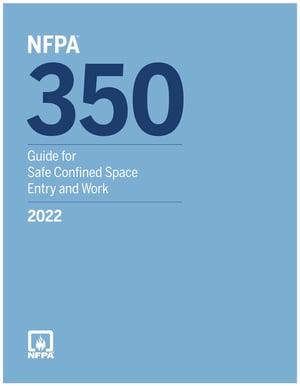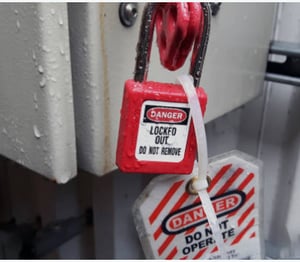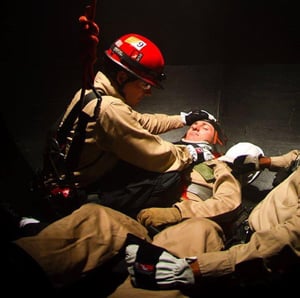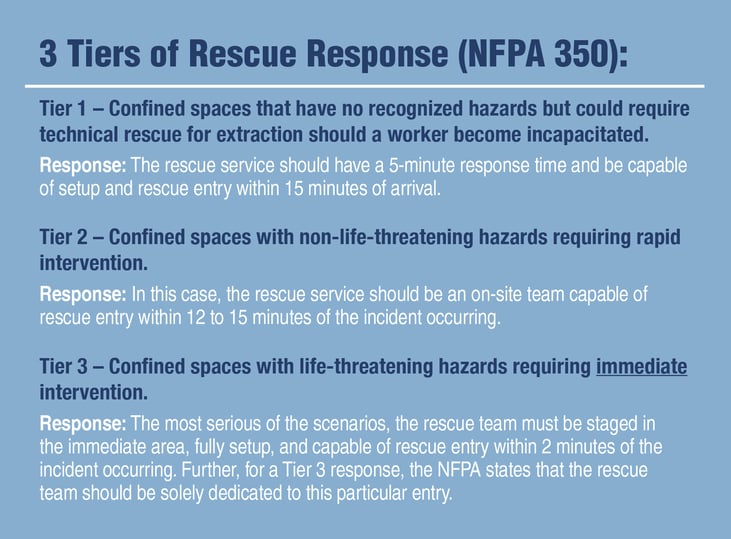What Does NFPA Have to Say about Confined Spaces? (Part 1)
 The National Fire Protection Association (NFPA) has released the 2022 edition of NFPA 350 Guide for Safe Confined Space Entry and Work. Developed through a consensus standards development process and reviewed for approval by the American National Standards Institute (ANSI), NFPA standards are afforded a place of immense importance in the world of emergency response.
The National Fire Protection Association (NFPA) has released the 2022 edition of NFPA 350 Guide for Safe Confined Space Entry and Work. Developed through a consensus standards development process and reviewed for approval by the American National Standards Institute (ANSI), NFPA standards are afforded a place of immense importance in the world of emergency response.
In the world of confined space rescue--and confined space work in general—it has been OSHA’s 1910.146 that has been most revered in the 30 years since its promulgation. But confined space rescuers and workers have long recognized that 1910.146 is a minimum-requirement standard that contains gaps along with causing some confusion in the way it handles terminology.
The newly released NFPA 350 aspires to close these gaps, simplify terminology, and provide practices workers and rescuers can follow. NFPA 350 has been careful not to conflict with 1910.146, but rather seeks to establish “best practices and how-tos for confined space entry, translating what is required in regulations into practical approaches” for everyday use.
 As NFPA standards go, one of the first things readers will notice is it is quite comprehensive and thus a very large standard. Regardless, everyone who has any dealings with confined space work should take the time to read and digest it in its entirety. In this article we will provide a high-level overview of the standard as it relates to confined space work and rescue in light of the content with which we are familiar in 1910.146.
As NFPA standards go, one of the first things readers will notice is it is quite comprehensive and thus a very large standard. Regardless, everyone who has any dealings with confined space work should take the time to read and digest it in its entirety. In this article we will provide a high-level overview of the standard as it relates to confined space work and rescue in light of the content with which we are familiar in 1910.146.
A primary difference of NFPA 350 from 1910.146 is how it—NFPA 350—handles terminology. The standard acknowledges that when there is confusion over terminology, that can translate into mistakes in workplace safety. And as we all know, these kinds of mistakes can translate into worker injuries and deaths. This has been the case where organizations debated as to whether they were dealing with a “permit-required confined space” or a “non-permit space” as defined in 1910.146.
The standard stresses the importance of verifying the competency of the rescue services selected. It specifically warns against assuming that all rescue services are prepared for entry-type confined space rescue.
NFPA 350 kept it simple by calling everything a “confined space” that meets 1910.146’s definition of a confined space, irrespective of the presence of atmospheric, engulfment, or internal configuration hazards.
Because NFPA 350 essentially treats every confined space in the same manner that 1910.146 treats a permit-required confined space, the default recommendation is to perform air monitoring in all confined spaces prior to entry. In light of the continued rate of fatalities in confined spaces involving bad atmospheres, we at Roco feel this requirement is well warranted.
Supporting the requirement for atmospheric monitoring, the standard also introduces new roles for confined space entry teams—Gas Tester and Ventilation Specialist. The “Ventilation Specialist” is self-explanatory, but a “Gas Tester” is a “qualified person responsible for operating a gas monitor and able to interpret results for atmospheric monitoring.” The inclusion of “able to interpret results” is a key component of the standard. Without this, testing can be ineffective at best, and deadly at worst.
 In addition to these new roles, the standard also directly addresses the hazards associated with lockout/tagout (or lack thereof), and the failure to blind or isolate with the role of Isolation Specialist. An “Isolation Specialist” is the “person responsible for protecting the confined space from the unwanted release of energy (electrical, mechanical, and/or hydraulic), as well as liquids, gases, chemicals, and other materials impacting upon the space.”
In addition to these new roles, the standard also directly addresses the hazards associated with lockout/tagout (or lack thereof), and the failure to blind or isolate with the role of Isolation Specialist. An “Isolation Specialist” is the “person responsible for protecting the confined space from the unwanted release of energy (electrical, mechanical, and/or hydraulic), as well as liquids, gases, chemicals, and other materials impacting upon the space.”
Rounding out the new roles is that of Standby Worker. A “Standby Worker” is a “person assigned to perform work in support of confined space operations.” The previous roles we are all familiar with from 1910.146—Entrant, Attendant, and Entry Supervisor—continue to be included on the confined space entry team.
A unique feature of NFPA 350 is that, along with these new roles, instruction—or “how to” guidance—is included. We consider this to be a major plus for anyone involved in confined space work. The standard provides valuable information on air monitoring, including selecting, calibrating, and using air monitors to test a confined space. And it also stresses the value of ventilation by describing the various types of ventilation devices and their configurations.
 While most of the standard is focused on keeping workers safe and preventing accidents, everyone is cognizant that as long as workers enter confined spaces, there will be accidents where rescue is required. The standard describes both non-entry rescue and entry-type rescue. Regardless of the method selected, the standard stresses the importance of verifying the competency of the rescue services selected. It specifically warns against assuming that all rescue services are prepared for entry-type confined space rescue.
While most of the standard is focused on keeping workers safe and preventing accidents, everyone is cognizant that as long as workers enter confined spaces, there will be accidents where rescue is required. The standard describes both non-entry rescue and entry-type rescue. Regardless of the method selected, the standard stresses the importance of verifying the competency of the rescue services selected. It specifically warns against assuming that all rescue services are prepared for entry-type confined space rescue.
NFPA 350 states that “[t]he degree and rapidity of response should be driven principally by the anticipated hazards.” To this end, it recognizes three levels, or tiers, of rescue response:

NFPA 350 is a very comprehensive standard and even delves into topics such as “Prevention through Design (PtD)” which seeks to prevent confined space emergencies through better design. Those with responsibilities involving confined space work or rescue are well advised to give it a read when you have the chance.
In this article, we reviewed the standard in broad strokes. In the follow up Part 2 Article, we will drill down more with a focus purely on the rescue aspect of the standard.




